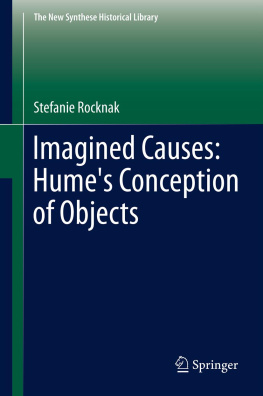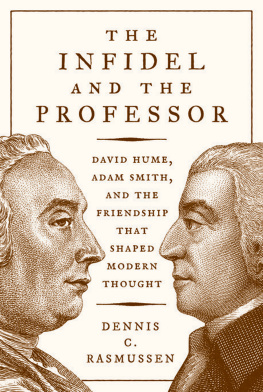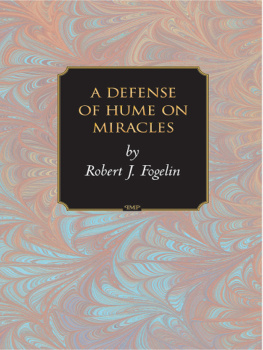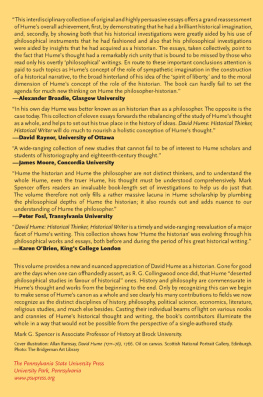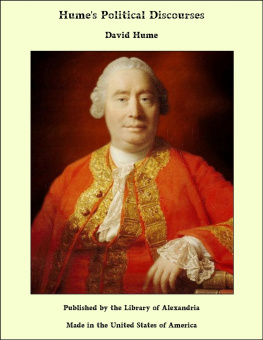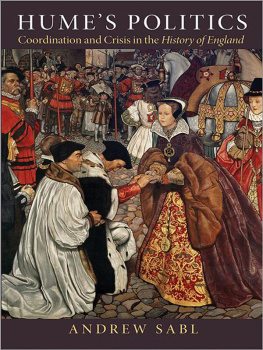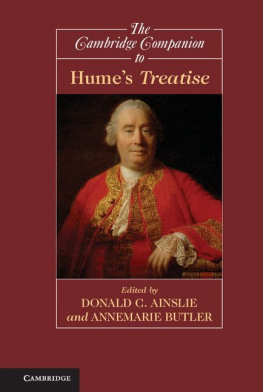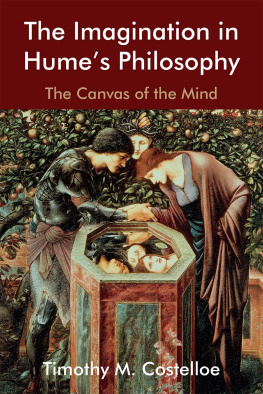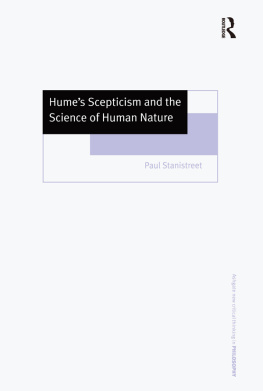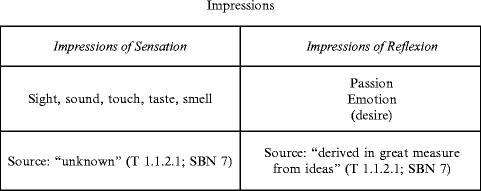Introduction
We begin by reacquainting ourselves with the distinction between impressions and ideas. In the course of doing so, we examine impressions of sensation v. impressions of reflection, simple v. complex reflections and memory v. imagination. Although these distinctions are fairly straightforward, they are not without controversy. One commentator has even suggested that Humes distinction between impressions and ideas is idio[tic] (Bennett , p. 28). However, if we realize that Hume is primarily engaged in a psychological, naturalistic project we see that these accusations are misplaced (where by naturalistic I simply mean empirical).
It is also shown in this chapter that an ideas exact representation of an impression is not its replication . For instance, I argue that according to Hume, the idea of a smell of a rose does not actually smell . This point comes into play in , where we discuss, respectively, what I call elementary beliefs and proto-objects. Both terms refer to impressions and/or ideas that exactly represent impressions.
Distinction #1: Impressions v. Ideas
What is an impression? An idea? On the very first page of the Treatise , Hume announces that All perceptions of the human mind resolve themselves into two distinct kinds, which I shall call Impressions and Ideas (
The distinction between impressions and ideas consists of differences in degrees of liveliness, ( 1) of sensation, passion and emotion tend to affect the human being in a much livelier, or vivacious way, than say, thinking about such things would. Thus, when we think about , or reflect about our impressions, or when we reason in general, we are engaged in the more removed realm of ideas , not impressions. For example, it is simply less intense to think about climbing a steep mountain, than to actually climb a steep mountain.
Hume takes this fundamental distinction between impressions and ideas to be so obvious that he remarks: I believe it will not be very necessary to employ many words in explaining this distinction. Every one of himself will readily perceive the difference betwixt feeling and thinking ( 2).
But, we have to ask, how could this be a rule if there are exceptions? Humes answer: This really isnt a rule, at least not a necessary rule. He explicitly tells us in the introduction to the Treatise that his method does not entail necessary principles, nor does it seek to discover them. Rather, he employs what Garrett ( xviii; emphasis added). None of the principles or maxims that Hume lays out in the Treatise are meant to be certain ; it would be an error for Hume to think as much. In fact, he writes:
if this impossibility of explaining ultimate principles shoud be esteemd a defect in the science of man, I will venture to affirm, that tis a defect common to it with all the sciences, and all the arts, in which we can employ ourselves, whether they be such as are cultivated in the schools of the philosophers, or practiced in the shops of the meanest artisans. None of them can go beyond experience, or establish any principles which are not founded on that authority. ( xviii; emphases added)
We cannot, Hume insists, go beyond experience, and so, we have the subtitle of the Treatise : An Attempt to Introduce the Experimental Method of Reasoning into Moral Subjects . It should be no surprise then, that Humes maxims admit of counterexamples. This method is squarely opposed to Descartes, Spinoza and Leibniz (c.f. Garrett (
Regardless of Humes self-avowed naturalism, some commentators, as mentioned above, complain that Humes distinction between impressions and ideas, and likewise, the distinction between feeling and thinking is, at worst, simple to the point of being idiotic (Bennett 45). However, remembering and imagining impressions does not, for the most part, produce the same experience as actually having an impression. Thus, generally speaking, the operations of the mind may be split into two categories: experience (i.e. impressions, or feelings) and ideas (i.e. thought).
2.1 A Note on Humes Psychological Method
Very generally put, a purely metaphysical and/or epistemological project appeals to logical rules and principles where certain conclusions necessarily follow from such rules and principles. For instance, Roth ().
Distinction #2: Impressions of Sensation v. Impressions of Reflection
Hume divides the three kinds of impressions noted above (sensations, passions and emotions) into two categories: impressions of sensation, which include all sensations (as well as pleasures and pains) v. impressions of reflexion, which include just impressions of passion and emotion: Impressions may be divided into two kinds, those of SENSATION and those of REFLEXION (
Furthermore, The first kind arises in the soul originally, from unknown causes. The second is derived in a great measure from our ideas (
This means that impressions of reflexion are generally caused by ideas of pleasure or pain, and tend to be passions, desires).
The Scope of the Memory and Imagination
According to Hume, our memories do not consist of sense impressions. Instead, they are ideas of impressions. For example, if we remember getting our thumb pricked, we do not relive the actual sensation . Instead, we remember an idea. This is why Hume only discusses ideas when he discusses the memory and the imagination in 1.1.3, Of the ideas of the memory and the imagination (emphasis added)these faculties do not apply to impressions. Note, for instance, the following description he gives of the memory, presented in conjunction with his description of the imagination:
We find by experience, that when any impression has been present with the mind, it again makes its appearance there as an idea ; and this it may do after two different ways: Either when in its new appearance it retains a considerable degree of its first vivacity, and is somewhat intermediate betwixt an impression and an idea; or when it entirely loses that vivacity and it is a perfect idea. The faculty, by which we repeat our impressions in the first manner, is called the MEMORY, and the other the IMAGINATION. ( 89; emphases added)
Although what is remembered has more vivacity than what is imagined (evidently, because what is remembered actually happened while what is imagined did not), and so is more like an impression (and so, is somewhat intermediate betwixt an impression and an idea), it is nevertheless an idea ; it makes its appearance there as an idea (emphasis added). Thus, if we relive any event or activity consisting of impressions, we do not relive those actual impressions, but instead, ideas of them. For example, remembering how the sun felt on my face is surely not the same as actually feeling the sensation of the sun on my face. The latter can cause actual skin damage while the former constitutes no danger whatsoever (and there would be no need for tanning salonseverybody could just sit at home and think about getting tan).

